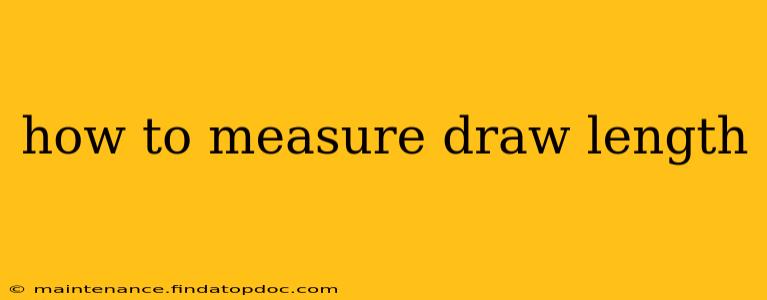Determining your correct draw length is crucial for accuracy, comfort, and injury prevention in archery. An incorrect draw length can lead to poor form, inconsistent shots, and even physical strain. This guide will walk you through various methods for measuring your draw length, ensuring you find the perfect fit for your archery setup.
Why is Accurate Draw Length Measurement Important?
Before diving into the methods, let's understand why accurate draw length is so vital. A draw length that's too long will force you to reach excessively, potentially causing shoulder injuries and impacting your accuracy. Conversely, a draw length that's too short will limit your power and precision. Finding the sweet spot ensures you can efficiently transfer energy to the arrow, resulting in consistent and powerful shots.
Common Methods for Measuring Draw Length
Several methods exist for determining your draw length. Each has its pros and cons, and some might be more suitable depending on your resources and experience level.
1. The Arm Span Method (Quick Estimation)
This is a quick and easy method, often used as a starting point.
-
How to: Extend your arms fully to the sides, measuring the distance between your fingertips. Divide this measurement by 2.5. This gives you a rough estimate of your draw length.
-
Pros: Simple and requires no special tools.
-
Cons: Inaccurate for many individuals; it's merely a starting point and should be refined using more precise methods.
2. The Back Tension Method
This method focuses on your back muscles rather than your arm length. It involves finding the point where you can comfortably hold your draw back using your back muscles instead of your arms.
-
How to: This requires practice and guidance. Ideally, it should be performed with an experienced archer or instructor. They will help you find the point where your back muscles are fully engaged, creating a stable and comfortable draw.
-
Pros: Often considered more accurate as it takes into account individual variations in posture and muscle engagement.
-
Cons: Requires an experienced archer or instructor, and practice to master the technique.
3. Using a Draw Length Measuring Device
Specialized draw length measuring tools are available in archery shops. These devices accurately measure your draw length while you’re holding the bow, ensuring a more precise measurement.
-
How to: Follow the manufacturer's instructions for using the specific device. Generally, you'll hold the bow and anchor, and the device will measure your draw length directly.
-
Pros: Highly accurate and reliable.
-
Cons: Requires purchasing a specialized tool.
4. The Full Draw Method (With Bow and Arrows)
This involves drawing the bow back to your full anchor point, then measuring the distance from the nock point on the arrow to the corner of your mouth.
-
How to: With the bow properly set up, draw the bow to your full anchor point. Carefully and safely measure the distance from the nock point to the corner of your mouth.
-
Pros: Relatively accurate if the bow is set up correctly and you have a consistent anchor point.
-
Cons: Requires having access to a bow and arrows and understanding proper archery form. Inaccurate if your form is not consistent.
How to Fine-Tune Your Draw Length
Even after measuring, you may need minor adjustments. Pay attention to your comfort and accuracy. If you experience shoulder discomfort or inconsistent shots, small adjustments to your draw length might be necessary. Consult with an experienced archer or archery instructor for personalized guidance.
What are the common draw length adjustments?
This is a commonly asked question, as a draw length change impacts more than just your comfort. The change can affect the spine and arrow flight. Therefore, adjusting it is not something to be undertaken lightly without guidance. Small adjustments should be made incrementally (1/8" or 1/4" at a time) and should be done by a qualified archer. There isn't a fixed answer for the type of adjustments needed, that depends completely on the archer's specifics.
What happens if my draw length is wrong?
Incorrect draw length can cause several issues. Poor posture, discomfort, shoulder and back injuries, inconsistent shot accuracy, and even reduced power are all possible. It's best to get your draw length right. Consider consulting an expert if you are unsure.
By following these methods and paying close attention to your body and the feedback you receive from your shots, you can determine your optimal draw length and enhance your archery experience. Remember, accuracy and safety are paramount, so seeking guidance from experienced archers is always recommended.
